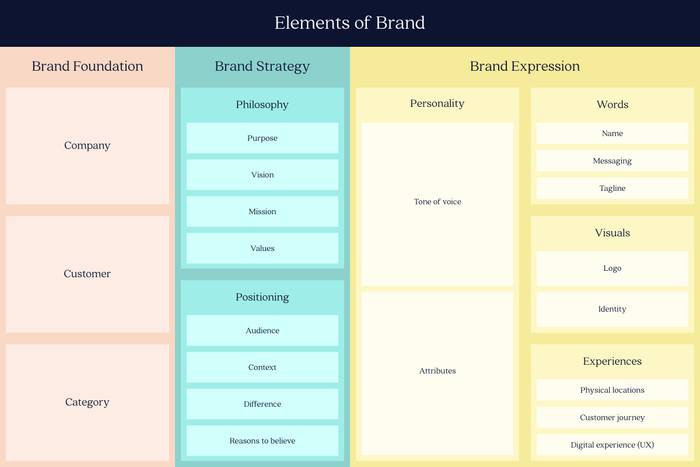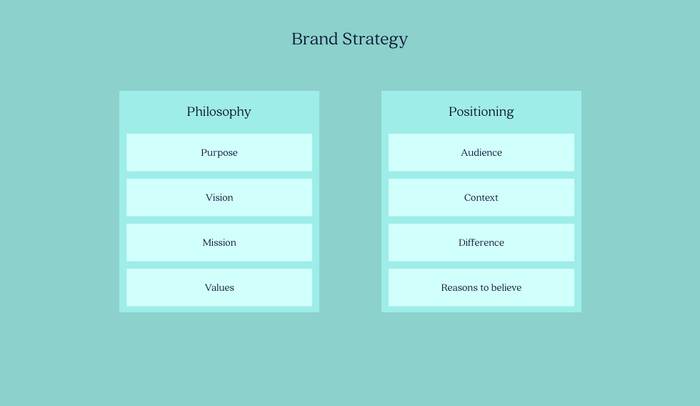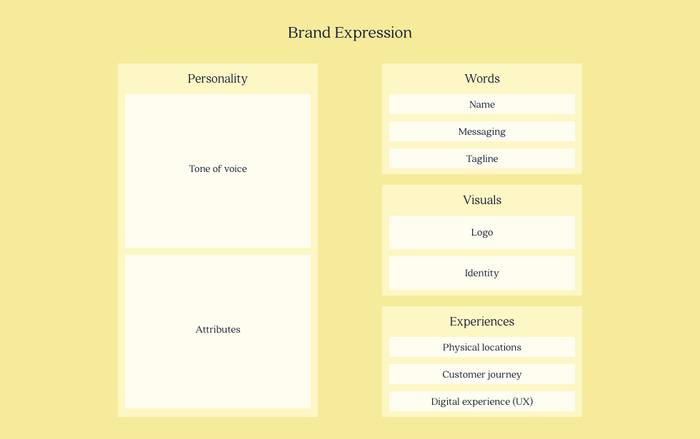When we think about what makes a brand, we generally think about the surface-level elements such as a logo, a tagline, a product or a particularly memorable ad campaign. In this post we dive beneath the surface and outline the elements that make a complete brand; a strategic brand with depth and substance.
Brand Foundation
Although not an inherent part of the brand itself, the 3 Cs provide the foundation from which any brand strategy is built.
Company
What does your company or organisation do? What products or services do you provide? How do you provide them? Understanding your strengths and weaknesses is the first foundational element of your brand strategy.
Customers
The second foundational element of a complete brand is an understanding of the ideal customer. Beyond market segments and target audiences, who are your customers? What defines them as people? Where do you find them and how do you connect with them?
Your brand cannot be all things to all people; trying to do so will have you headed straight for the great void of brands that lost: no man’s brand.
Category
A brand cannot exist in a vacuum. An understanding of the category and context within which you operate is the third and final C of brand development. Brands exist in people’s minds and they can only stick in the mind if they can be sorted into a particular category.
What trends are sweeping the industry? How are consumer behaviours evolving? What emerging technologies are shaping the future?
Who else operates in the category? Analysing your competitors—their strengths and weaknesses—is crucial in devising a winning strategy.
Brand Strategy
Strategy is about playing to win. A good brand strategy will make sure you stay relevant and build strong connections between your organisation and the people you choose to serve.
Brand strategy is divided into 2 areas: philosophy and positioning.
Brand Philosophy
Your philosophy is what gives your brand depth and substance so that it resonates with your chosen audiences by connecting with them on an emotional level. The elements of your brand philosophy act as guiding principles that inform decisions and shape the behaviours of your brand.
Purpose
Your brand purpose is the reason you exist beyond making money. What impact do you want to have? Whether you want to change the world or serve a small local community, your purpose statement sets the direction of the brand.
Mission
Your mission focuses on the present; it describes how you intend to create value every day.
Vision
Your vision looks to the future; it’s a shared vision of what successfully completing your mission would look like.
Values
In the same way that, as people, we each have our own beliefs and values that will influence our behaviour, the same is true of brands.
Your values are a set of core beliefs that you stand for as a brand. Typically listed as single word attributes with short supporting statements, these values should be embodied in your everyday actions and should serve as a North Star for decision making.
Positioning
Positioning is about the position that you want to hold in people’s minds. Imagine the mind as a big filing system where brands are categorised, ranked and then filed accordingly. Your positioning strategy is about differentiating from your competitors to ensure that your brand is at the front of the folder—the most readily available—when someone searches their mind for your category.
Brand Expression
This is where your brand comes to life. Your name, your logo, your personality and tone of voice, these elements are all an expression of your brand; rooted in the brand strategy and designed to convey a specific message or feeling associated with the brand.
Brand Personality
Brands are often described as being like people and the expectation of modern consumers is for brands to show more and more human-like qualities. Consider your customers, if your brand were a person, what type or person would connect with those customers? Who would fit in with that crowd? Define the attributes of your brand’s personality and think about how that personality might behave in different situations.
Tone of Voice
Your tone of voice is the expression of your brand personality through your choice of words—both written and spoken. The tone with which you communicate tells your audience how you feel about your message and therefore will influence how they feel about that message.
Written and Verbal Communication
You need to write the message before you spread the word. From your brand name through to your tagline, slogan and key messages through to your website copy, press releases and how you engage with your audience on social media, every piece of communication shapes the way people feel about you and influences the creation of the brand in people’s minds.
Visual Communication
Your visual identity system is the visual representation of your brand. Typically comprising a logo, typography, colour palette and imagery such as photography, illustrations, icons and other graphical devices, the goal of your brand identity is to be distinctive so that your unique style becomes easily recognised.
Brand Experiences
How does the brand come to life through physical spaces and digital experiences? From office spaces to store locations to events; from your website to social media channels to email marketing; your sales process, customer support experience and exit process, these are all experiences of your brand and will influence how people feel about your organisation. Design each touch point so that it reflects your personality and feels uniquely tailored to your brand.
The Complete Brand
All of these elements build upon one another and combine together to create a complete strategic brand. Without the strategic elements of a brand, all that remains is a shallow surface layer. Savvy modern consumers can detect brands lacking in substance and will resist parting with their cash to support them.
Fancy a good ol' chat about the values of brand strategy to your business?
Drop us a linePost by

Amy joined in 2014 to set up our Content department. She now heads up a growing Brand and Content team, utilising over 13 years’ experience to deliver brand awareness through targeted, multi-channel copy. As well as engaging content for websites and blogs, Amy delivers PR strategies and tone of voice exploration, helping clients to communicate the purpose and values of their brand with maximum impact.
Project







